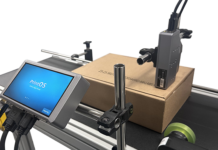By Neil Cook (product marketing manager – TTO, Domino Printing Sciences) and David Croft (product marketing manager – DOD Ink Jet, Domino Printing Sciences)
A recent study conducted by Smithers Pira has revealed that the global market for flexible packaging is set to experience an annual growth rate of 3.4% over the next five years, with an expected value of €217 billion by 2020.
There are a number of factors that justify this prediction. First of all, flexible packs are being increasingly seen across stores in both the Western and Far Eastern markets. In China, for example, research shows that an increasing number of consumers prefer to buy flexibly packaged goods, as these are viewed as a trendier, more practical and a more environmentally friendly alternative to rigid packs.
However, it would be a mistake to think that flexible packaging’s growth is purely down to aesthetic appeal. Lighter to handle and easier to store, flex packs are gradually replacing glass and tin products, as businesses aim to reduce stock space and remove excess weight from the supply chain.
With this in mind, flex packs also make for more environmentally friendly packaging – for instance, coffee producers are now opting for refill bags rather than the traditional glass jar. With sustainability proving to be a key driver for an increasing number of industries, what used to be single use, cut-corner and throwaway packs have now become re-sealable airtight products, ensuring perishable contents remain in good condition and that material wastage is significantly reduced.

THE NEED FOR CODES IN FLEXIBLE PACKAGING
Primary packaging across a range of industries often has a mandatory legal requirement to fulfil, particularly relevant in the food sector, where traceability is and continues to grow as a critical requirement. The ability for a customer to trace a product back to the supplier and/or manufacturer is a legal obligation, while traceability of production batches and packaging lines is for the benefit of the manufacturer. With the amount of data recorded set to increase over the years, more complex codes will need to be printed onto each package.
Furthermore, codes also fill an important promotional function in primary packaging. For example, by printing a variable data code, marketers can run competitions or loyalty campaigns, where consumers only need to scan the code with their mobile devices in order to engage directly with a brand.
WHICH CODING TECHNOLOGY WILL BENEFIT MY BUSINESS?
Although a number of coding solutions are available for flexible packaging, the need for high quality human and machine readable codes has seen the increase of Thermal Ink Jet (TIJ) and Thermal Transfer Overprinting (TTO) technologies.
For the high volume, high speed flow wrapping applications encountered in the confectionery industry for example, TIJ proves to be an ideal solution. TIJ systems use solvent and water based ink to print complex codes on a wide variety of substrates at a fast repeat rate, while still delivering the required legibility expected from the codes. The ability to easily integrate a TIJ print head into multilane applications also make it suitable for wider web coding applications. Employing multiple print heads to deliver individual and unique codes across the substrate’s surface from a single controller gives significant cost and productivity benefits.
On the other hand, the codes found on a packet of crisps or sweets will most likely have been produced by a TTO system. With ability to print 300 dpi quality codes, TTO has become a firm favourite for coding flexible pouches and bags. Being able to print in intermittent applications, TTO offers a better choice for large area variable data printing, as it is able to print larger quantities of information onto the packet. TTO is gaining widespread recognition as a replacement to out-dated hot stamp and roller coders, and ensures there are no ink migration issues through the packaging substrate.
So what technology should you choose for your business? Although there may be many possibilities as to which system is the best, the choice will be affected by a number of key factors, including the substrate, line speed, environmental issues and of course the amount of data that needs to be printed on the packaging’s surface.













